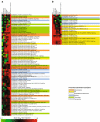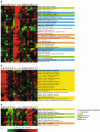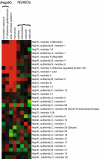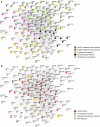Meta-analysis of heat- and chemically upregulated chaperone genes in plant and human cells
- PMID: 20694844
- PMCID: PMC3024091
- DOI: 10.1007/s12192-010-0216-8
Meta-analysis of heat- and chemically upregulated chaperone genes in plant and human cells
Abstract
Molecular chaperones are central to cellular protein homeostasis. In mammals, protein misfolding diseases and aging cause inflammation and progressive tissue loss, in correlation with the accumulation of toxic protein aggregates and the defective expression of chaperone genes. Bacteria and non-diseased, non-aged eukaryotic cells effectively respond to heat shock by inducing the accumulation of heat-shock proteins (HSPs), many of which molecular chaperones involved in protein homeostasis, in reducing stress damages and promoting cellular recovery and thermotolerance. We performed a meta-analysis of published microarray data and compared expression profiles of HSP genes from mammalian and plant cells in response to heat or isothermal treatments with drugs. The differences and overlaps between HSP and chaperone genes were analyzed, and expression patterns were clustered and organized in a network. HSPs and chaperones only partly overlapped. Heat-shock induced a subset of chaperones primarily targeted to the cytoplasm and organelles but not to the endoplasmic reticulum, which organized into a network with a central core of Hsp90s, Hsp70s, and sHSPs. Heat was best mimicked by isothermal treatments with Hsp90 inhibitors, whereas less toxic drugs, some of which non-steroidal anti-inflammatory drugs, weakly expressed different subsets of Hsp chaperones. This type of analysis may uncover new HSP-inducing drugs to improve protein homeostasis in misfolding and aging diseases.
Figures






Similar articles
-
The heat-shock protein/chaperone network and multiple stress resistance.Plant Biotechnol J. 2017 Apr;15(4):405-414. doi: 10.1111/pbi.12659. Epub 2017 Feb 23. Plant Biotechnol J. 2017. PMID: 27860233 Free PMC article. Review.
-
Identification and expression analysis of heat shock protein family genes of gall fly (Procecidochares utilis) under temperature stress.Cell Stress Chaperones. 2023 May;28(3):303-320. doi: 10.1007/s12192-023-01338-9. Epub 2023 Apr 18. Cell Stress Chaperones. 2023. PMID: 37071342 Free PMC article.
-
Chaperone network composition in Solanum lycopersicum explored by transcriptome profiling and microarray meta-analysis.Plant Cell Environ. 2015 Apr;38(4):693-709. doi: 10.1111/pce.12426. Epub 2014 Oct 1. Plant Cell Environ. 2015. PMID: 25124075
-
Transcriptional profiling of Arabidopsis heat shock proteins and transcription factors reveals extensive overlap between heat and non-heat stress response pathways.BMC Genomics. 2007 May 22;8:125. doi: 10.1186/1471-2164-8-125. BMC Genomics. 2007. PMID: 17519032 Free PMC article.
-
Prospects of engineering thermotolerance in crops through modulation of heat stress transcription factor and heat shock protein networks.Plant Cell Environ. 2015 Sep;38(9):1881-95. doi: 10.1111/pce.12396. Epub 2014 Aug 6. Plant Cell Environ. 2015. PMID: 24995670 Review.
Cited by
-
Allyl-isothiocyanate treatment induces a complex transcriptional reprogramming including heat stress, oxidative stress and plant defence responses in Arabidopsis thaliana.BMC Genomics. 2016 Sep 17;17(1):740. doi: 10.1186/s12864-016-3039-x. BMC Genomics. 2016. PMID: 27639974 Free PMC article.
-
Proteomic data from human cell cultures refine mechanisms of chaperone-mediated protein homeostasis.Cell Stress Chaperones. 2013 Sep;18(5):591-605. doi: 10.1007/s12192-013-0413-3. Epub 2013 Feb 21. Cell Stress Chaperones. 2013. PMID: 23430704 Free PMC article.
-
Synergism between a foldase and an unfoldase: reciprocal dependence between the thioredoxin-like activity of DnaJ and the polypeptide-unfolding activity of DnaK.Front Mol Biosci. 2014 Jul 31;1:7. doi: 10.3389/fmolb.2014.00007. eCollection 2014. Front Mol Biosci. 2014. PMID: 25988148 Free PMC article.
-
The penalty of stress - Epichaperomes negatively reshaping the brain in neurodegenerative disorders.J Neurochem. 2021 Dec;159(6):958-979. doi: 10.1111/jnc.15525. Epub 2021 Oct 31. J Neurochem. 2021. PMID: 34657288 Free PMC article. Review.
-
Proteomics analysis reveals novel host molecular mechanisms associated with thermotherapy of 'Ca. Liberibacter asiaticus'-infected citrus plants.BMC Plant Biol. 2016 Nov 14;16(1):253. doi: 10.1186/s12870-016-0942-x. BMC Plant Biol. 2016. PMID: 27842496 Free PMC article.
References
-
- Aalinkeel R, Bindukumar B, Reynolds JL, Sykes DE, Mahajan SD, Chadha KC, Schwartz SA. The dietary bioflavonoid, quercetin, selectively induces apoptosis of prostate cancer cells by down-regulating the expression of heat shock protein 90. Prostate. 2008;68(16):1773–1789. doi: 10.1002/pros.20845. - DOI - PMC - PubMed
Publication types
MeSH terms
Substances
LinkOut - more resources
Full Text Sources

